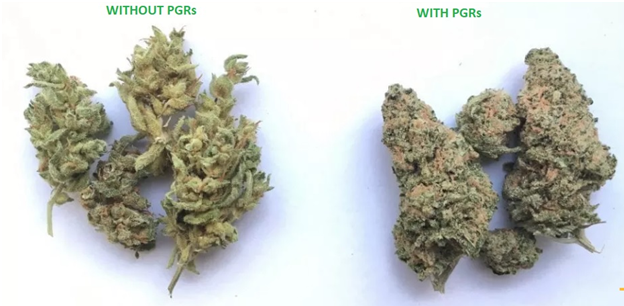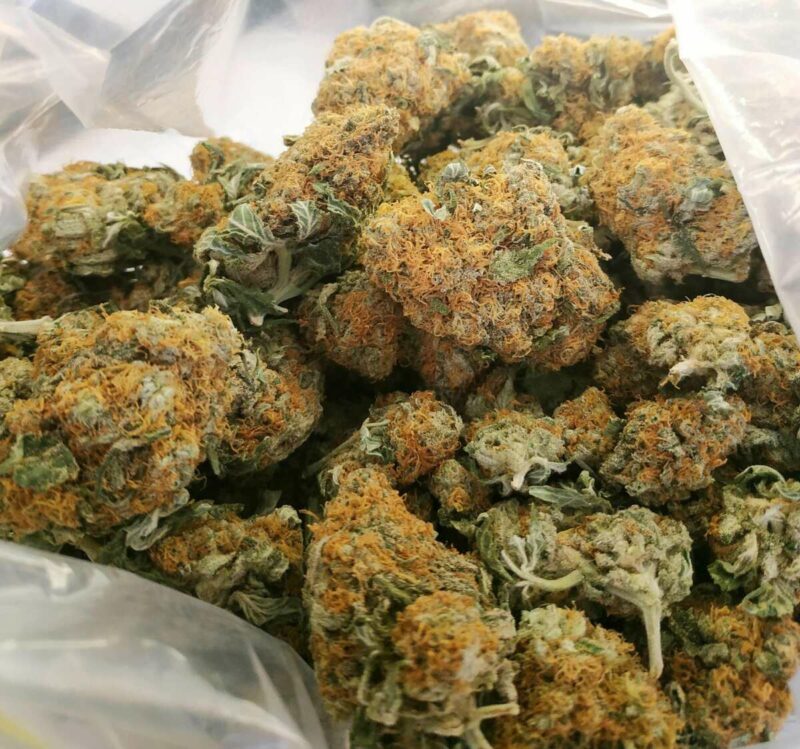PGR weed is increasingly becoming common in many states as more marijuana growers are now adopting chemical methods to improve their yields. If you are an experienced stoner, you can tell the difference between the PGR weed and non-PGR weed. This is not a new topic as it is discussed in different forums.
Have you seen marijuana buds covered by ugly brown hairs? Do they have scents that are familiar to you, or do they smell something else? If you have come across such marijuana buds, then you might have been smoking PGR weed.
PGR weeds, what is it? How do you identify it from other marijuana grown naturally? Do they have any side effects on your health? Continue reading to find out more because that is what this article is all about.
What is PGR Weed?
PGR Weed or Plant Growth Regulator weed is a marijuana plant whose growth and structure have been modified using plant growth hormones. PGRs are artificial growth hormones used by growers to induce faster growth of plants, control roots, trigger flowering, and alter any other growth characteristics. PGR weed refers to cannabis plants cultivated with these chemicals.
PGRs have practical uses in plant growth for many reasons, but not for consumables. When applied to any plant, the results are remarkable, but the reality is the exact opposite when such plant products are consumed. It causes no harm when used for growing hedges and grass in your lawn.
PGR weeds grow faster and produce high yields, making them beneficial to a farmer but a disaster to the consumer. We will explore its adverse health effects later.
There are many plant growth regulators hormones for growing different plants. But for cannabis, the following are the most common:
- Paclobutrazol – makes the cannabis plant grow faster and form larger buds.
- Daminozide (Alar) – increases the overall bud yield
- ChlormequatChloride – accelerate growth and flowering
The above list consists of the most dominant three weed PGRs. If you are a marijuana grower and against PGRs in weed, then you should explore more. Here is a list of PGR nutrients for cannabis you should avoid for a non-PGR weed:
- Rock Juice
- Boonta Bud
- Rox
- Mega Bud
- Bushload
- Gravity
- Phosphoload
- Superbud
- Dr. Nodes
- Yield Masta/Sudden Impact
PGR Weed Side Effects
Plant growth regulators put a smile on the farmers’ faces but send consumers to their graves early. While researchers meant no harm by discovering these artificial plant hormones, unscrupulous farmers have been abusing them for their own selfish gain.
PGR weed is toxic and has many side effects. If you can, then you should avoid them at all costs. Fortunately, we will also tell you how to identify PGR cannabis. Stick to natural weed as much as you can. Farmers should also avoid PGRs in weed. Be concerned more with the well-being of consumers and not what you stand to gain. After all, naturally grown marijuana also gives high yields.
Side effects of PGRs on human health can be divided into two: short-term and long-term. How your body will react to exposure to these growth stimulation chemicals depends on the exposure time.
Short-term Effects (accidental exposure)
You do not necessarily have to consume weed grown with PGRs to get exposed to these toxic chemicals. It is possible to get into contact with plant growth regulators by accident. That short-time exposure will immediately trigger body responses as listed below:
- Skin and/or eye irritations
- Respiratory distress
- Nausea
- Vomiting, etc.
The signs depend on your immunity and genetic makeup. You might experience one or a combination of the above effects or none when exposed to PGRs.
Long-term Effects
This is where the regular cannabis consumers belong. Long-term consumption of PGR weed has adverse side effects that can lead to an untimely death in severe cases. Some of the signs you might experience include the following:
- Lung damage
- Damage to reproductive health in both men and women
- Low amino acid levels in the brain
- Low antioxidant in the brain
- Prenatal health complications
How to Spot PGR Weed
Marijuana smokers are called upon to be on the lookout for PGR weeds and distance themselves from them. This is the only approach that can reduce PGR in weeds. The business is still thriving because consumers do not know how to distinguish PGR cannabis from natural weed.
Once growers lack a market for the paclobutrazol weed or any marijuana grown with any other plant hormone, they will stop this vice. We aim at enlightening the unsuspecting PGR bud consumers so that they can stop buying PGR weed. But can you tell if the flower you are about to buy was grown with chemicals or not?
PGR vs non-PGR weed

PGR weeds are characteristically distinguishable from natural weeds. The buds have different features, and cannabinoid content also varies considerably. PGR in marijuana lead to the following features:
- PGR buds have little to no scent
- Buds feel spongey
- Unusually dense buds with unusual hardness
- Fewer trichomes/crystals
- The weight to size ratio of the buds is high
- Buds have rounded and smooth edges comparable to individual nuggets
- Orange PGR buds: dense orange hairs on the weed, sometimes red hairs
- Excessively dense weed
- THC content much lower than the cannabis strain average
- Harsh chemical taste
- Hits much faster and stronger – often associated with headache
- PGR buds turn dull brown when dried and cured
Identifying PGR cannabis should not be challenging if you are familiar with natural marijuana flowers. Cease from smoking anything suspected for your own sake and enlighten other stoners on your friend’s list.
Best PGR-Free Cannabis at The Lodge Dispensaries
The best way to ensure you do not consume PGRs weed is to avoid buying weeds from the black market. The prices might be lucrative, but your life is priceless. Buying cannabis and its related products from a certified dealer or dispensary is the safest way to get chemical-free products.
At The Lodge Dispensaries, we take care of our customers. Here, you will access your favorite marijuana strain, and quality is guaranteed. We value your safety. We sell non-PGR weed and encourage responsible consumption of cannabis and its products. Check out our menus for the best weed strain at affordable prices.
FAQs
What does PGR stand for?
PGR is an acronym for Plant Growth Regulators. These are artificial growth hormones used for modifying the growth characteristics of plants. PGRs in weeds encourage flowering, bud formation, faster germination, among others.
What are PGR buds?
A PGR bud is a bud formed by marijuana grown with plant growth regulators. These are chemicals used by growers to improve the growth characteristics of weed for better yields.
How do you spot PGR Bud?
PGR buds are more dense, hard to break and have fewer or no crystals/trichomes. They are usually covered in thick orange hairs or red hairs. They also do not have scents, and if they do, it is not as intense as it would in natural marijuana.
Why do cannabis growers use PGRS in weed cultivation?
Plant growth regulators have been used in agriculture and landscaping for many years. However, their use in agriculture is tightly regulated by law to protect consumers, which is mostly not the case in the cannabis industry. The regulations are not very strict, allowing unscrupulous weed growers to use these chemicals for high yields.


Great information thank you from NorCal
Thank you for sharing
Great information So products like bat guano and worm castings are those qualified is safe for consumption and what other types of dirt or products that are safe for consumption
There are hundreds of natural products on the market. OMRI listed products are good places to start.
I have read and viewed many articles on medical cannabis growing and uses. Your shared info is outstanding in it’s presentation. Never have I viewed this subject matter or heard of it. When first securing medical cannabis card I tried in vain grow product not realizing it to a PCR process. Thanks so very much for reeducating me.
Thanks a bunch for the info. Wasn’t aware of that stuff but I think I’ve came across it a time or two. The fowl smell and headache is what click’d and I wouldn’t be surprised if a lot of people are using different types of growth aids. In fact, some of them names of chemicals sounded familiar and I don’t even grow that much. But unfortunately that is going to come with the territory of the drug trade that always looks out for profits over safety. But thanks again for the 411 bc now I at least know what to look for.
I can almost confirm that all weed in NY is now PGR. It’s exactly how you describe it and absolutely impossible to feel any THC effects at all. I thought I was losing my mind, as none of it even remotely smokes like weed. It goes down your throat more like a cigarette, with no instinct to cough whatsoever, no resin found at the end of any smoked joints, and the smell & taste almost nonexistent, as well as being dry as a bone. All the local dealers are selling similar if not precisely the same strains as medical & it’s all PGR. Looks beautiful but completely impotent.I haven’t seen or smoked any actual real bud in over a year and I’m officially lost.
No resin on joints? I am sorry to inform you. That was extracted buds likely still intact. Even good looking CBG should leave resin.
As of this moment, there is no proof to back up the claims of adverse health effects.
WRONG. It was banned on food crops by the FDA in 1989 because of the health risks.
https://www.youtube.com/watch?v=uxVDFXrPRo8
PGRs are banned from food crops since the 80s. They are only authorized to be used for ornamental shrubs and trees. There is no doubt that the quality of weed has suffered recently. When you get buds that are rock hard, something is wrong. I knew something was fishy so I’ve been researching this and it makes sense that growers are adding PGRs. An ounce of PGR weed only fills up a baggie maybe halfway because it’s so heavy. It’s a shame if growers are knowingly doing this to make profit but don’t be surprised. God will get you for this.
I’ve been trying to figure out for a couple years was been wrong with my weed suddenly it’s spongy or won’t break up even in a grinder it’s hard as a rock practically makes me cough my brains out I get super high but it doesn’t last long there’s no trichrome‘s Hardly any smell and so hard to pull and draw from a joint can’t keep a joint lit a bowl doesn’t stay lit never gets burning it’s like fake weed I just realized it’s been what’s been wrong with me for about two years now. This stuff is garbage and it’s even like that from the dispensary. There’s no way I’m gonna continue to smoke growth hormones. There has been no weed that doesn’t fit this description in New York in about five years. I guess it’s time to quit because instead of getting high half the time I end up feeling sick. Tired headache crappy. It’s the growth hormone I’m convinced now oh and the fact it doesn’t stay lit is an absolute aggravating nightmare I can’t stand anymore. i have to lite it so many times you’re smoking burnt crap. Can’t even get good seeds anymore. .. auto blooming miniature dwarf crappy waste of my time plants is what I end up with. Watch otjer drug use go up now. I’m not the only one that’s not gonna want to smoke this crap anymore.
Although the article was well-written and contained much useful information, the “list of things to look for” is misleading to some degree. Density of flower is ultimately determined by 1st: Genetics. If you’re grown Purple Urkle or GSC, compare the structure of those to say, Sour Diesel or GG4. You can’t make Sd come out like Urkle or Cookies when it comes to density. 2: Lumen intensity. I’m at 2200’ elevation, people who grow at sea level accuse me of using PGR’s, but that’s because they don’t get flowers this hard. It’s not as simple as the above list makes it seem..:
Right PGRs are sucktown. But I feel like they’re telling us that any dense hairy weed is PGR garbage. Plus it’s confusing they say PGR bud is spongey but also abnormally hard. In my experience that sort of textural factor is mostly determined by the drying and curing process. Definitely good to let people know to look out…just could be a little clearer about exactly what to look out for.
Their are natural pgrs like kelp extracts etc.
This is a fine example of why you must grow your own. I eat all of the leaves I trim while plant training and defoliating also, so, even my leafy greens are totally in my care to be organic and clean. Hey, my tents in my finished basement is cleaner than any form of produce sales, handled, boxed, shipped by truck, stocked on a shelf with fucking water sprayed all over it, out in the open public space of a grocery. That’s just gross. From farm to table is just upstairs for me now. I feel like a champion because I am free from any chance of consuming garbage. Eating cannabis leaves is helping me lose weight, a benefit I had never considered until I was growing my own and seeing just how very many leaves must be trimmed and eaten. Way better than that nasty kale. My organic, homegrown bud is easily better than the store weed, yours can be too.
PGR weed is awful but you make incorrect assumptions. I’ve been a smoker and grower for over 20 years and am all organic and no pgr- my genetics are tight and have lots of red hairs. You can not always go by sight alone!
I’m a cultivator for a medical cannabis company, just want to say thanks for info here,at work we make sure nothing we use has PGRs. I would like to point out one thing tho,and that’s you can’t tell if a grower used PGRS by a rounded smooth bud. Most companies like ours have invested in Mobius trimming machine which tumbles the buds through a tube of blades,so what comes out at the end is smooth and rounded.
Informative article 🏆
I am not so sure about the “how to identify PGR buds” info in this article. I know some growers who are 100% living soil growers who have very dense red hair covered buds. Dense buds are a result of high intensity LED lights CO2 enrichment and great genetics. PGR may create very dense hairy buds but it by no means the only way. Fluffy airy non-dense buds are not the only “PGR” free option out there.